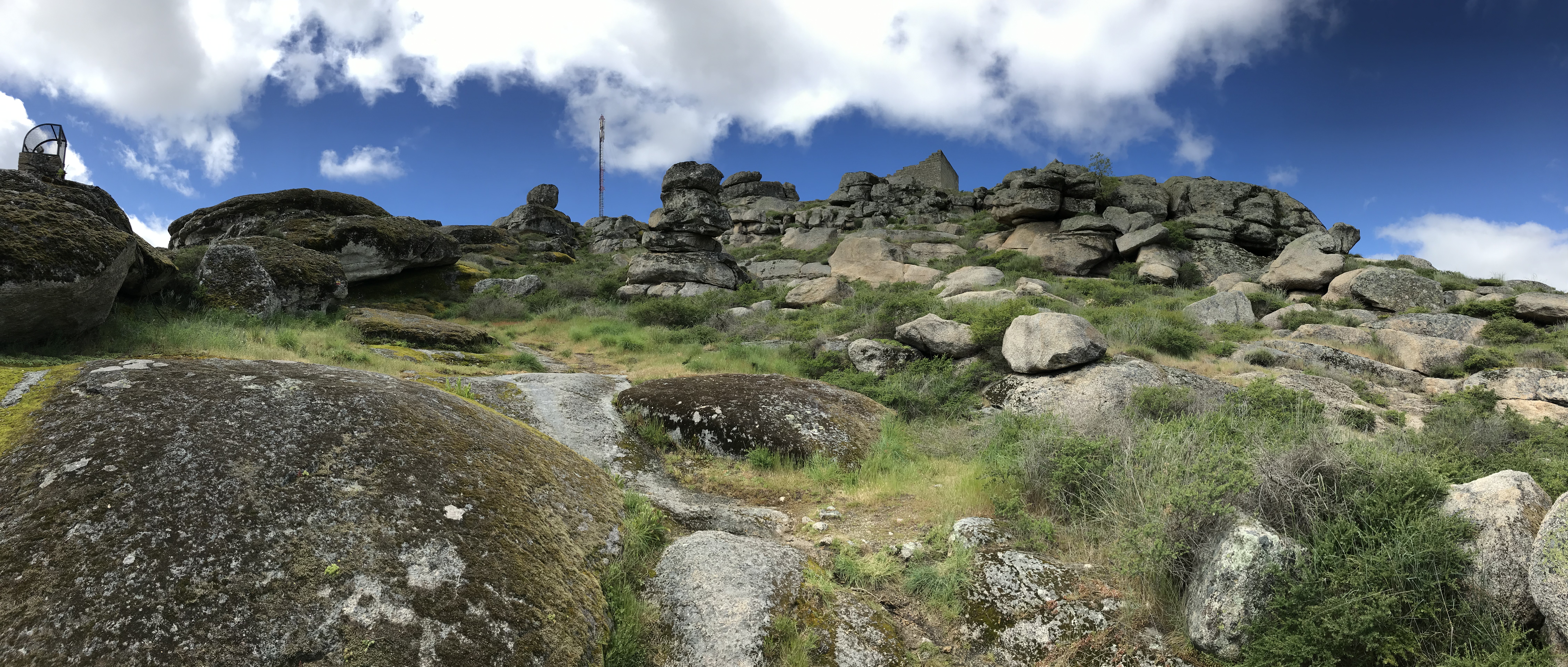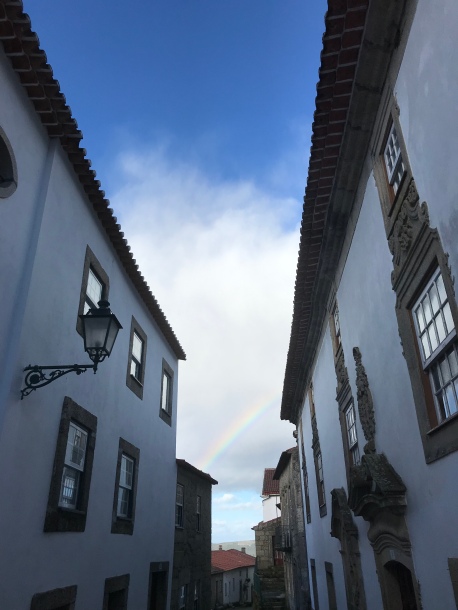I didn’t have a lot of expectations when I drove up the winding road leading to Monsanto. I passed two of the town’s famed giant boulders at a narrow turn and I could see the beginnings of the beige stone walls that I associate with quaint, European towns. My GPS had stopped working an hour ago and the blue triangle that was supposed to be me floated on a road-less expanse.
When I first started telling people I was driving to Monsanto for a long holiday weekend, most of them said: Monsanto? Like the drug company that causes cancer? Portuguese friends said: Where?
I learned about Monsanto from my Lonely Planet guidebook. After a month of living in Portugal, I was antsy to take a trip that didn’t involve another visit to Lisbon for an embassy appointment. I don’t know how I landed upon the two-pages that talk about Monsanto, but within thirty minutes I’d booked a car and one of the few accommodations I could find.

Monsanto is a town built around boulders. Homes and shops are squeezed deftly between massive stones, giving the vibe that the town is trying to camouflage itself. In 1938, the village was voted The Most Portuguese Town in Portugal. They received a silver rooster, the symbol of Portugal, to commemorate the honor.
As I entered the town, I passed a few buildings: some with brand new white stucco and others in the typical beige/gray stonework I’ve seen around most of Portugal. The street narrowed and the incline grew steeper. I finally stopped the car after turning a sharp corner and realizing I was on a street where, if Google Maps was wrong, I could only reverse to get out.
One of the owners of my guesthouse, Nuno, met me outside my car. I followed him up stairs that didn’t look like stairs, but rather rocks in the ground that just happened to form an unsteady upward path. Around one corner was a bolder twice the size of my rental car. A small, rocky stone path led up and around the massive rock, to what I assumed was someone’s home. Nuno and I turned away from the rock, walked a bit further down a small path, and then up four steep steps into the guesthouse.


Honestly, I have been struggling to write this post for months because I don’t know what to say about Monsanto other than go there now.
Why? Here are a few reasons:
Go to Monsanto if you like:
Beautiful scenery
The town looks like something out of a fairy tale book, not because it’s your typical quaint, quite, stone-housed village, but because the boulders make everything look just different enough that it’s like you’re in a magic realm.
The town is also just so charming. There is no other word: charming.


Because Monsanto is the highest spot for miles, the views are spectacular.


Hiking
Despite the fact that I am a self-proclaimed city girl, I also love hiking in the countryside (I just don’t want to live on a hiking trail). If you like hiking, Monsanto is an ideal location. The town is situated on a cliff and just walking around the town is a bit of a hike because there are so many ups and down.
At the peak of the mountain, about one kilometer straight up from the town, are the ruins of a castle: Castelo de Monsanto. To get to the castle, you have to hike up large slabs of rocks, which make you wonder where did the boulders originate from and am I about to create a landslide? From the castle, you can see the entire surrounding area. You can even see Spain.


The surrounding countryside also provides a lot of hiking opportunities and the Camino de Santiago even runs through this area.

Hospitality
I traveled to Monsanto solo. At the time I was desperately missing Thailand and my community there (still am, honestly). I wanted a weekend away to myself to decompress and collect my thoughts about my recent move across the world. The owners of my guesthouse, Nuno and Carla, however, were having none of my solo-ness. Every night when I arrived back the guesthouse they were waiting for me with a glass of wine by the fireplace. When I said I was allergic to red wine, they opened a bottle of champagne. One night they invited me to have dinner with them and we dined on fire-cooked salmon, vegetables, and potatoes.
In front of the fireplace, Nuno, Carla, and I covered a wide range of topics. I learned they met while working in a bank in Lisbon. They’d only opened the guesthouse recently, which is why it looked so much like an actual home rather than a guesthouse. They’d hosted less than twenty guests. Nuno was from Monsanto and was torn between wanting more people to discover the Most Portuguese Town in Portugal and wanting the town to remain the same. Animal statues on their dining room table were turned away from the door, which Nuno and Carla said symbolized good luck.

In addition to Nuno and Carla, each person I met was incredibly nice and accommodating. On my first night, I went to one of two restaurants in Monsanto that stays open past 7 p.m. The owner sat me at a window table, and then proceeded to tell every other person who entered that they couldn’t be seated without a reservation. Maybe I took someone’s reservation by mistake, or maybe I just looked so lost the woman took pity on me. A cafe owner was also patient as I stumbled through ordering a galão. I know I am particularly biased towards Monsanto hospitality because of Nuno and Carla, but every single local person I met was just extremely nice. I cannot 100% say that of the other places I’ve been in Portugal.
Unique places
Despite its physical appearance, Monsanto is just unique in general. During our fireside chats, Nuno regaled me with much of Monsanto’s history. He told me that it is not only The Most Portuguese Village in Portugal, but it is one of twelve official Historical Villages of Portugal. Most of these villages played a strategic role in defending the country from invaders throughout the centuries. Because Portugal is such a small country, much of this strategy didn’t come from mass, brutish soldiers, but instead cunning ploys that made use of limited resources.
Monsanto, for example, had been under siege by the Romans for over six years during the BC era. When the citadel eventually got down to its last sack of grain and last calf, all looked lost. Knowing they were on the brink of surrender, the village leader decided to feed the entire bag of grain to the calf. He then threw the calf over the castle walls. When the poor animal exploded in front of the soldiers, they were amazed at how much food the village must have if they were willing to waste so much so spitefully. The Romans couldn’t afford the standoff much longer, so they headed home. Monsanto commemorates this victory at the beginning of May every year, but now they throw flowers over the wall instead of fatted calfs.
Nuno also told me that the population of Monsanto is about 80, and the median age range is about 80 as well.
“They closed down the school three years ago,” he said. “There aren’t any kids to attend. No one is young enough.”
I wanted to ask Nuno if he and Carla would have kids to put in that school, but it took nearly my full stay to riddle whether they were coworkers or a couple (spoiler: they’re a couple). Despite a severely aging population, Monsanto doesn’t have a hospital, and a pharmacist and physician visit the town only twice a week.
“What if someone has an emergency?” I asked.
Nuno shrugged.

You will not like Monsanto if you like:
To party
As I said: the town has a population of 80 and a median age of 80. From what I could tell, there were three restaurants (Nuno said only two, but I swear I saw a third), a handful of cafes, and two or three shops. The latest any restaurant stays open is 8 p.m.
Monsanto is ideal for couples who just want to snuggle and be romantic (my weekend boyfriend was my Kindle). For people who want some semblance of a rockin’ nightlife? You should probably just keep driving to Lisbon…
Oxygen
The village of Monsanto is about 2,400 ft above sea level (750 m). I realize that to some people that’s like barely a hill, but if you’re like me and you grew up at 9 ft (3 m) above sea level, then 2,400 is A LOT. Even though I once lived at 7,500 ft (2,290 m) above sea level, my lungs are sea level lungs and they are probably still swirling with Bangkok smog. If you’re someone who is not fantastic with higher altitudes, just be aware and drink water.
All I’m really saying is…
Go to Monsanto.
In the five months that I have been trapped in Portugal due to visa legalities (more on that later), I have visited seven Portuguese towns. Although I know I still have more to see, Monsanto remains my absolute favorite place. In Thailand, I had one treasured place that I made a point to return to before leaving the country. As of now, Monsanto is that same place for me in Portugal.


Leave a comment